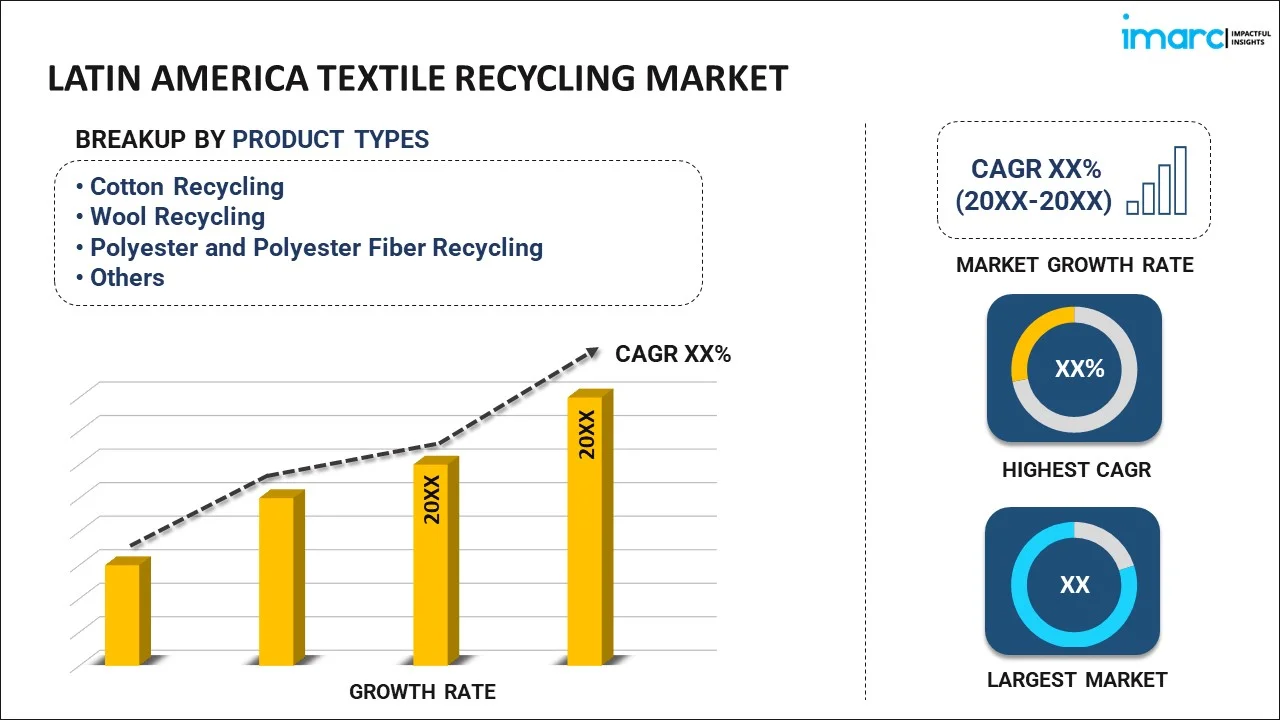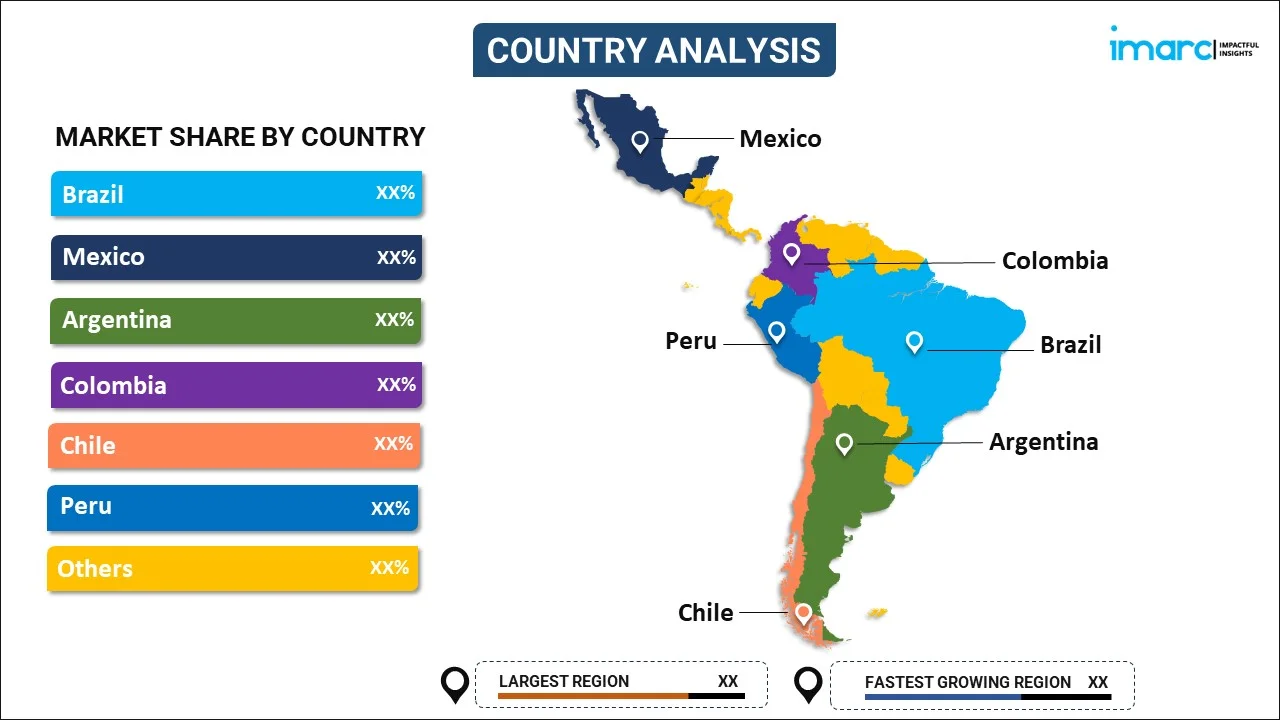
Latin America Textile Recycling Market Report by Product Type (Cotton Recycling, Wool Recycling, Polyester and Polyester Fiber Recycling, Nylon and Nylon Fiber Recycling, and Others), Textile Waste (Pre-consumer Textile, Post-consumer Textile), Distribution Channel (Online Channel, Retail and Departmental Store), End User (Apparel, Industrial, Home Furnishings, Non-woven, and Others), and Country 2025-2033
Market Overview:
Latin America textile recycling market size reached USD 280.8 Million in 2024. Looking forward, IMARC Group expects the market to reach USD 520.6 Million by 2033, exhibiting a growth rate (CAGR) of 6.6% during 2025-2033. The increasing environmental awareness, supportive government policies, sustainable fashion trends, cost-effective production, advanced recycling technologies, collaborative partnerships, and the widespread adoption of circular economy principles represent some of the key factors driving the market.
|
Report Attribute
|
Key Statistics
|
|---|---|
|
Base Year
|
2024 |
|
Forecast Years
|
2025-2033
|
|
Historical Years
|
2019-2024
|
| Market Size in 2024 | USD 280.8 Million |
| Market Forecast in 2033 | USD 520.6 Million |
| Market Growth Rate (2025-2033) | 6.6% |
Textile recycling is a sustainable process that involves collecting, reusing, or repurposing textile products to extend their lifecycle and minimize environmental impact. It encompasses various activities aimed at diverting textiles, such as clothing, fabric scraps, and other textile materials, from landfills and incinerators. The primary goal of textile recycling is to reduce waste, conserve valuable resources, and decrease the carbon footprint associated with textile production. This process typically begins with the collection of discarded textiles, which can be sourced from individual donations, clothing banks, or even post-consumer waste. Once collected, these textiles undergo sorting and cleaning processes to separate items that are suitable for reuse from those that require further processing. Reusable items may be resold or donated, while damaged or unsuitable textiles can be broken down into fibers for use in manufacturing new textile products or for other applications like insulation or padding. Textile recycling helps promote sustainability by conserving raw materials and reducing textile waste and helps address social and economic aspects by creating job opportunities and supporting charitable endeavors.
Latin America Textile Recycling Market Trends:
The Latin America textile recycling market has been experiencing robust growth, driven by rising environmental consciousness and concerns about the detrimental effects of textile waste. Besides this, stringent government regulations and policies promoting sustainable textile practices are creating a conducive environment for recycling initiatives, fueling the market growth. Moreover, the fast-paced fashion industry's constant demand for raw materials has propelled the need for alternative, sustainable sources, such as textile recycling, thereby aiding in market expansion. In line with this, the shifting consumer preferences toward eco-friendly and ethically sourced products have boosted the demand for recycled textiles, thereby strengthening the market growth. Concurrently, the high costs associated with textile production, including resource and labor expenses prompting manufacturers to explore cost-effective recycling options, are contributing to the market expansion. In confluence with this, significant technological advancements in recycling technologies have made the process more efficient and economically viable, providing an impetus to the market growth. Additionally, extensive partnerships and collaborations among textile manufacturers, recyclers, and fashion brands have led to increased awareness and the promotion of recycled textiles, propelling the market forward. At the same time, the increasing affordability of recycled textile products is attracting price-conscious consumers, creating a positive outlook for the market expansion. Furthermore, the growing emphasis on circular economy principles has encouraged companies to embrace textile recycling as a means to reduce waste and minimize their carbon footprint, thereby supporting the market growth.
Latin America Textile Recycling Market Segmentation:
IMARC Group provides an analysis of the key trends in each segment of the market, along with forecasts at the regional and country levels for 2025-2033. Our report has categorized the market based on product type, textile waste, distribution channel, and end user.
Product Type Insights:

- Cotton Recycling
- Wool Recycling
- Polyester and Polyester Fiber Recycling
- Nylon and Nylon Fiber Recycling
- Others
The report has provided a detailed breakup and analysis of the market based on the product type. This includes cotton recycling, wool recycling, polyester and polyester fiber recycling, nylon and nylon fiber recycling, and others.
Textile Waste Insights:
- Pre-consumer Textile
- Post-consumer Textile
A detailed breakup and analysis of the market based on the textile waste have also been provided in the report. This includes pre-consumer textile and post-consumer textile.
Distribution Channel Insights:
- Online Channel
- Retail and Departmental Store
The report has provided a detailed breakup and analysis of the market based on the distribution channel. This includes online channel and retail and departmental store.
End User Insights:
- Apparel
- Industrial
- Home Furnishings
- Non-woven
- Others
A detailed breakup and analysis of the market based on the end user have also been provided in the report. This includes apparel, industrial, home furnishings, non-woven, and others.
Country Insights:

- Brazil
- Mexico
- Argentina
- Colombia
- Chile
- Peru
- Others
The report has also provided a comprehensive analysis of all the major regional markets, which include Brazil, Mexico, Argentina, Colombia, Chile, Peru, and Others.
Competitive Landscape:
The market research report has also provided a comprehensive analysis of the competitive landscape. Competitive analysis such as market structure, key player positioning, top winning strategies, competitive dashboard, and company evaluation quadrant has been covered in the report. Also, detailed profiles of all major companies have been provided.
Latin America Textile Recycling Market Report Coverage:
| Report Features | Details |
|---|---|
| Base Year of the Analysis | 2024 |
| Historical Period | 2019-2024 |
| Forecast Period | 2025-2033 |
| Units | Million USD |
| Scope of the Report | Exploration of Historical and Forecast Trends, Industry Catalysts and Challenges, Segment-Wise Historical and Predictive Market Assessment:
|
| Product Types Covered | Cotton Recycling, Wool Recycling, Polyester and Polyester Fiber Recycling, Nylon and Nylon Fiber Recycling, Others |
| Textile Wastes Covered | Pre-consumer Textile, Post-consumer Textile |
| Distribution Channels Covered | Online Channel, Retail and Departmental Store |
| End Users Covered | Apparel, Industrial, Home Furnishings, Non-woven, Others |
| Countries Covered | Brazil, Mexico, Argentina, Colombia, Chile, Peru, Others |
| Customization Scope | 10% Free Customization |
| Post-Sale Analyst Support | 10-12 Weeks |
| Delivery Format | PDF and Excel through Email (We can also provide the editable version of the report in PPT/Word format on special request) |
Key Questions Answered in This Report:
- How has the Latin America textile recycling market performed so far and how will it perform in the coming years?
- What has been the impact of COVID-19 on the Latin America textile recycling market?
- What is the breakup of the Latin America textile recycling market on the basis of product type?
- What is the breakup of the Latin America textile recycling market on the basis of textile waste?
- What is the breakup of the Latin America textile recycling market on the basis of distribution channel?
- What is the breakup of the Latin America textile recycling market on the basis of end user?
- What are the various stages in the value chain of the Latin America textile recycling market?
- What are the key driving factors and challenges in the Latin America textile recycling?
- What is the structure of the Latin America textile recycling market and who are the key players?
- What is the degree of competition in the Latin America textile recycling market?
Key Benefits for Stakeholders:
- IMARC’s industry report offers a comprehensive quantitative analysis of various market segments, historical and current market trends, market forecasts, and dynamics of the Latin America textile recycling market from 2019-2033.
- The research report provides the latest information on the market drivers, challenges, and opportunities in the Latin America textile recycling market.
- Porter's five forces analysis assist stakeholders in assessing the impact of new entrants, competitive rivalry, supplier power, buyer power, and the threat of substitution. It helps stakeholders to analyze the level of competition within the Latin America textile recycling industry and its attractiveness.
- Competitive landscape allows stakeholders to understand their competitive environment and provides an insight into the current positions of key players in the market.
Need more help?
- Speak to our experienced analysts for insights on the current market scenarios.
- Include additional segments and countries to customize the report as per your requirement.
- Gain an unparalleled competitive advantage in your domain by understanding how to utilize the report and positively impacting your operations and revenue.
- For further assistance, please connect with our analysts.
 Request Customization
Request Customization
 Speak to an Analyst
Speak to an Analyst
 Request Brochure
Request Brochure
 Inquire Before Buying
Inquire Before Buying




.webp)




.webp)












